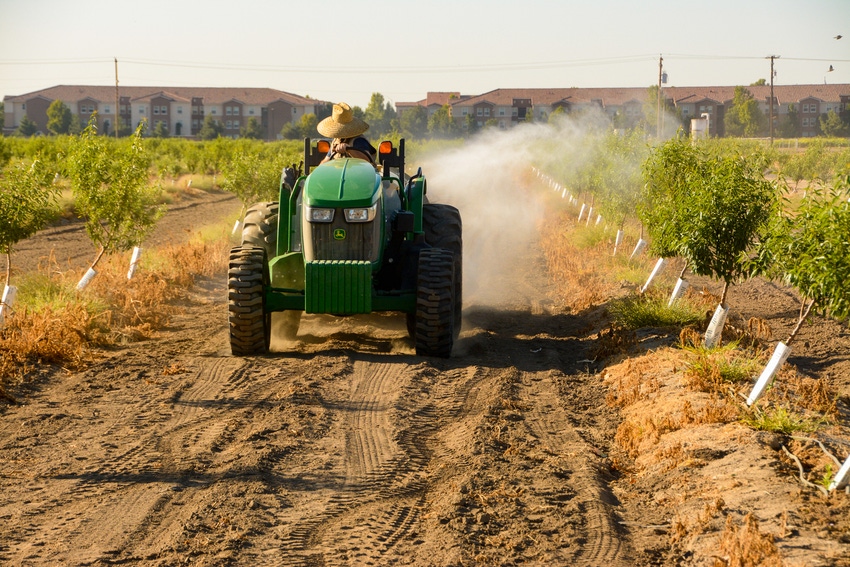
Researchers at California Ste University's Fresno State campus are finding efficiencies in two separate on-farm systems helping growers more efficiently manage their margins in two common areas: irrigation and chemical applications.
Rob Willmott, Fresno State's orchard manager, saw an immediate savings in time and chemicals used with technology he learned about at this year's World Ag Expo in Tulare, Calif.
Willmott, a 2013 Fresno State graduate with a plant science degree, oversees 190 acres of nuts, olives, citrus and stone fruit on the university farm that spans 1,000 acres where the cities of Fresno and Clovis meet.
His first experience with the AgOtter sprayer system in a 36-acre almond block on the university farm netted him a $4,000 savings in chemicals alone. Factor the time it would have taken the driver to refill the Air-O-Fan sprayer several more times and the cost to run the small tractor, and the savings get even greater.
“In my opinion it’s much more environmentally friendly,” Willmott says. “It reduces the amount of fertilizers and pesticides you use on the crop.”
Where Willmott sees significant savings is in an electronic eye precision sprayer system made by Arag that senses plant density and mass. This turns on and off the spray rig, which in the large gaps between trees in young almond orchards is where he sees significant savings and environmental benefits.
“It’s hard for the driver to drive this field and turn on and off the sprayer with every tree because of the orchard configuration,” he said.
Willmott demonstrated the system using water in an Air-O-Fan sprayer. The system detected the small almond trees and turned on that side of the fan as it passed a tree. In those spots of young almonds where an occasional tree had died the sprayer did not turn on.
The AgOtter system software allows him to monitor tractors through GPS, control the rate of spray and record the information to a desktop program for his chemical use reports. Through live-view access, he can monitor tractors in real time in the field. He can watch students apply products in the field.
Spray rates are controlled through ground speed sensors, meters and the controller, which continuously adjusts valves to ensure target rates are maintained. All this can be controlled and monitored from a smart phone or iPad.
The AgOtter app allows operators to view gallons-per-hour, tractor speed, total acres applied and the volume of materials applied through a variety of different spray configurations, according to company owner Greg Guyette at Tempe, Ariz. The system will work with any liquid spray applications, he says.
Information on the AgOtter system is available at http://www.agotter.com/.
Irrigation demonstration
Fresno State is also working with an irrigation system provided by Netafim and CalWest Rain that lets Willmott effectively adjust water applications, depending on the soil type and the tree's needs.
The system was dedicated earlier this year in a ceremony featuring Fresno State President Joseph Castro and Jordan Agricultural College Dean Sandra Witte.
“We sincerely appreciate Netafim for making Fresno State the first campus farm to utilize this irrigation technology,” Witte said.
Within a 36-acre block of almonds planted in March 2016 are three soil types, ranging from a sandy soil to heavier clay. Prior to planting, Willmott said the field was mapped based on soil type. He now has a chart with the three distinct soil types in different colors.
The system was designed and installed by CalWest Rain, and includes six control valves and dual-drip irrigation lines, Netafim tubing, water meters, control valves, and a filter control box and more.
Through smart technology, the system allows growers to use computers and cell phones to inspect data that can be cross-referenced with GIS technology, plus weather and productivity maps.
Almonds in this study are the Burchell Nursery Supareil nut, which according to the Burchell website is larger than the Nonpareil almond with color, shape and taste resembling the Nonpareil.
In some cases, those soil types can change from one, to the other, then the other in a single row of trees. Willmott is able to control irrigation in those rows simply by controlling how long the water flows through the drip emitters.
Campus Farm Manager David Sieperda likes to keep soil moisture down to three feet in the profile, something Willmott says he’s learning. His previous practice was to keep the profile wet only in the top 18 inches.
This appears to have a positive impact on trees as one of Willmott’s studies has been to measure trunk girth on the trees and watch the changes based on the different soil types. This process has allowed him to watch trees in those soils that do not have the necessary fertility, and to augment them with proper fertilizers.
The study was part of Willmott’s project as a 2016 graduate of the Almond Board of California’s leadership program.
Soil sensors in various locations on the university farm are used in conjunction with other methods to ensure crops are effectively irrigated.
The donated irrigation system comes with its own fertigation and pump.
“We can now spoon feed these trees just what they need,” Willmott says.
For more information, visit http://calwestrain.com/ and www.netafimusa.com/.
About the Author(s)
You May Also Like






